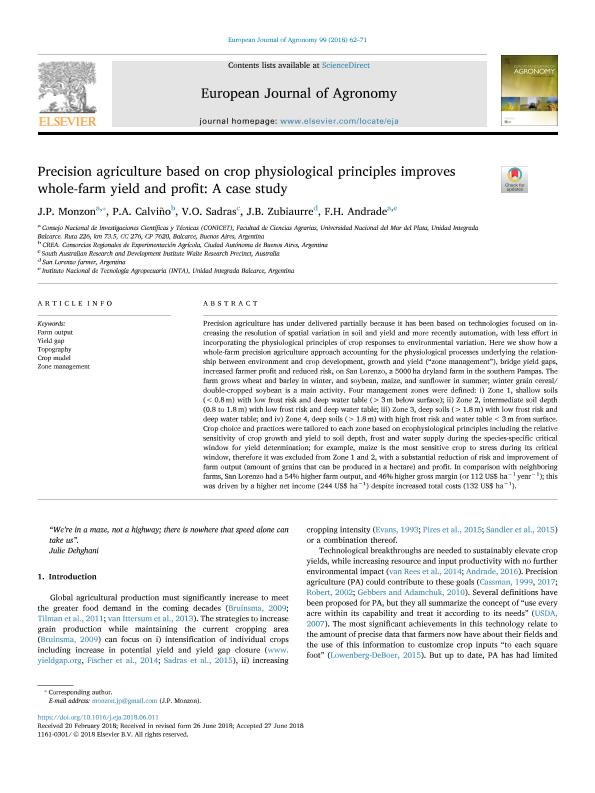Artículo
Precision agriculture based on crop physiological principles improves whole-farm yield and profit: A case study
Monzon, Juan Pablo ; Calviño, P. A.; Sadras, Victor Oscar
; Calviño, P. A.; Sadras, Victor Oscar ; Zubiaurre, J. B.; Andrade, Fernando Héctor
; Zubiaurre, J. B.; Andrade, Fernando Héctor
 ; Calviño, P. A.; Sadras, Victor Oscar
; Calviño, P. A.; Sadras, Victor Oscar ; Zubiaurre, J. B.; Andrade, Fernando Héctor
; Zubiaurre, J. B.; Andrade, Fernando Héctor
Fecha de publicación:
09/2018
Editorial:
Elsevier Science
Revista:
European Journal of Agronomy
ISSN:
1161-0301
Idioma:
Inglés
Tipo de recurso:
Artículo publicado
Clasificación temática:
Resumen
Precision agriculture has under delivered partially because it has been based on technologies focused on increasing the resolution of spatial variation in soil and yield and more recently automation, with less effort in incorporating the physiological principles of crop responses to environmental variation. Here we show how a whole-farm precision agriculture approach accounting for the physiological processes underlying the relationship between environment and crop development, growth and yield (“zone management”), bridge yield gaps, increased farmer profit and reduced risk, on San Lorenzo, a 5000 ha dryland farm in the southern Pampas. The farm grows wheat and barley in winter, and soybean, maize, and sunflower in summer; winter grain cereal/double-cropped soybean is a main activity. Four management zones were defined: i) Zone 1, shallow soils (< 0.8 m) with low frost risk and deep water table (> 3 m below surface); ii) Zone 2, intermediate soil depth (0.8 to 1.8 m) with low frost risk and deep water table; iii) Zone 3, deep soils (> 1.8 m) with low frost risk and deep water table; and iv) Zone 4, deep soils (> 1.8 m) with high frost risk and water table < 3 m from surface. Crop choice and practices were tailored to each zone based on ecophysiological principles including the relative sensitivity of crop growth and yield to soil depth, frost and water supply during the species-specific critical window for yield determination; for example, maize is the most sensitive crop to stress during its critical window, therefore it was excluded from Zone 1 and 2, with a substantial reduction of risk and improvement of farm output (amount of grains that can be produced in a hectare) and profit. In comparison with neighboring farms, San Lorenzo had a 54% higher farm output, and 46% higher gross margin (or 112 US$ ha−1 year−1); this was driven by a higher net income (244 US$ ha−1) despite increased total costs (132 US$ ha−1).
Palabras clave:
Crop Model
,
Farm Output
,
Topography
,
Yield Gap
,
Zone Management
Archivos asociados
Licencia
Identificadores
Colecciones
Articulos(CCT - MAR DEL PLATA)
Articulos de CTRO.CIENTIFICO TECNOL.CONICET - MAR DEL PLATA
Articulos de CTRO.CIENTIFICO TECNOL.CONICET - MAR DEL PLATA
Citación
Monzon, Juan Pablo; Calviño, P. A.; Sadras, Victor Oscar; Zubiaurre, J. B.; Andrade, Fernando Héctor; Precision agriculture based on crop physiological principles improves whole-farm yield and profit: A case study; Elsevier Science; European Journal of Agronomy; 99; 9-2018; 62-71
Compartir
Altmétricas



